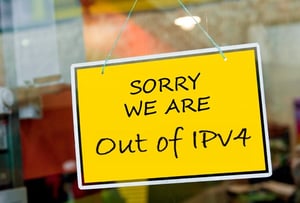Running out of IPv4 Addresses? Here are two options.
If you are an ISP and haven't experienced your own IPv4 shortage yet, you most likely have  heard that IPv4 addresses are getting hard to come by. This is sending many Internet providers into panic mode when they realize they are almost out. The end of IPv4 had been predicted for a long time, but the date when those addresses would finally be gone kept getting pushed back. This may have convinced many network professionals that perhaps they could put off the move to IPv6 until after they retired so someone else could deal with the problem.
heard that IPv4 addresses are getting hard to come by. This is sending many Internet providers into panic mode when they realize they are almost out. The end of IPv4 had been predicted for a long time, but the date when those addresses would finally be gone kept getting pushed back. This may have convinced many network professionals that perhaps they could put off the move to IPv6 until after they retired so someone else could deal with the problem.
If you haven't been keeping up with the official status of IPv4, for all practical purposes those addresses are gone. You can no longer get allotments from the Regional Internet Registries like ARIN (North America), RIPE (Europe) and APNIC (Asia). Ironically, IPv4 itself is not going away any time soon. Even though IPv6 is now rolled out in many places, and there are no new IPv4 addresses available, most networks are not ready to handle IPv6 traffic and will not be for some time. So, even if you convert your network to all IPv6, you will still need a way for your subscribers to access websites that remain on IPv4 networks.
If you’re already feeling the pinch from a shortage of IPv4 addresses, and you aren't quite ready to make the move to IPv6, you don't have to hit the panic button just yet. You still have two options.
You can buy IPv4 addresses in the after-market
One of the first things you may look into is purchasing IPv4 addresses. Since we never had to pay for IP addresses in the past, there is understandably a certain amount of resistance built in to this option for many. It's also not cheap. The average going resale rate currently for a /24 block of 256 IP addresses is about $18.00 per address, so doing the math, you’ll spend about $4,600. If a /24 doesn’t meet your needs, there are other size blocks you can get. For example, a /22 (1,024 addresses) will run you about $18,000 and a /20 (4,096 addresses) about $75,000. If you really expect to grow, you can get a /19 (8,192 addresses) for just over $150,000. You'll also need to consider the time that it will take your backbone provider to route the new IPv4 addresses every time you get a new block, so add that to your schedule and to-do list when considering your options.
You can deploy Carrier Grade NAT (CGNAT)
Obviously, buying IPv4 addresses is not a great long-term solution for ISPs who plan on growing their subscriber base. A better solution for you may be deploying Carrier Grade NAT (CGNAT). With CGNAT in place you can conserve the IPv4 addresses you already have by letting multiple subscribers share a single public IP address. When CGNAT is done right you are also able to track the activity of every subscriber who was using that address, so you can respond to law enforcement requests and subpoenas as you normally would. By conserving IPv4 addresses CGNAT gives you time to plan your migration to IPv6 without having to purchase more addresses. And, when you are ready to make the jump to all an all IPv6 network, CGNAT can handle the needed translations between your IPv6 subscribers and any IPv4 websites that are still lurking out there.
The cost of CGNAT will vary based on the type of product and capabilities. Proprietary hardware solutions are expensive, but they are well suited for the task and often have additional features that might be of value. However, these may be priced out of reach for small to mid-sized operators. There are also software-based CGNAT solutions that can be run on standard servers or in a virtual environment. This solution may scale better for smaller providers and is more economical, but there is also the complexity of installing and configuring everything.
At ZCorum, we make both options available for our customers. We can provide a proprietary hardware solution if that is the desire, or a software-based license if that is the right fit. And, on our software-based CGNAT option, we handle the complexity for you. We install the software on standard hardware that we purchase, configure everything, and provide you with a CGNAT appliance that is plug and play when you get it. You can read about both CGNAT solutions here.
Even if you have plenty of IPv4 addresses now and are not ready to fully transition your network infrastructure to IPv6, you will still need to make that move eventually. And when you do, you will need a way to provide access to the remaining IPv4 content for your subscribers—that is, unless you plan on being the last IPv4 network on the planet. I would suggest you don't wait that long.
About the Author: Rick Yuzzi

Never miss a post.
Enter your email to subscribe:
- Ask an Expert (12)
- Blog (12)
- Technology (11)
- Hot Topics (8)
- ask a broadband expert (8)
- DOCSIS (7)
- PNM (7)
- proactive network maintenance (7)
- Industry Perspectives (5)
- BEAD (4)
- Broadband Funding (4)
- Customer Service (4)
- FCC (4)
- IIJA (4)
- PreEqualization Analyzer (4)
- correlation groups (4)
- fiber broadband (4)
- fiber optics (4)
- fiber troubleshooting (4)
- interview (4)
- CGNAT (3)
- Carrier Grade NAT (3)
- DDoS Attacks (3)
- DOCSIS pre-equalization (3)
- Diagnostics (3)
- Distributed Denial of Service Attacks (3)
- GPoN (3)
- IPv4 Conservation (3)
- Purchase IPv4 Addresses (3)
- What is DOCSIS PNM (3)
- broadband infrastructure funding (3)
- fiber (3)
- 5G (2)
- CALEA (2)
- CALEA Compliance (2)
- Codeword Errors (2)
- DOCSIS 3.1 (2)
- Distributed Access Architecture (2)
- Group Delay (2)
- ICFR (2)
- IP traffic (2)
- IPv6 migration (2)
- In Channel Frequency Response (2)
- Main Tap Compression (2)
- Marketing (2)
- Micro Reflections (2)
- Millimeter Wave (2)
- OTT (2)
- Rural Broadband (2)
- Types of DDoS Attacks (2)
- Voice Service (2)
- XGS-PON (2)
- broadband data collection (2)
- customer service (2)
- internet issues (2)
- mid-band spectrum (2)
- mmWave (2)
- network traffic (2)
- network virtualization (2)
- state broadband (2)
- state broadband program (2)
- weather-related Internet issues (2)
- 10G (1)
- BDC (1)
- BDC Availability Data Specification (1)
- BDC User Guide (1)
- BEAD Funding (1)
- Broadband Providers (1)
- Broadband Serviceable Location Fabric (1)
- Broadband Serviceable Locations (1)
- C-Band (1)
- CA Certificate Expiration (1)
- CAF II Requirements (1)
- CAF II Testing (1)
- CALEA SSI Plan (1)
- CBRS (1)
- Carpet Bombing (1)
- Citizens Broadband Radio (1)
- Communications Assistance for Law Enforcement Act (1)
- Connect America Fund (1)
- DAA (1)
- DOCSIS 4.0 (1)
- DOCSIS CA Certificate Expiration (1)
- DPoE (1)
- DPoG (1)
- EPoN (1)
- Excel Text Matching (1)
- Extended Spectrum DOCSIS (1)
- Extending HFC Life (1)
- FCC Broadband Map (1)
- FCC data (1)
- FTTH (1)
- FTTx (1)
- Fidelity Communications (1)
- Full Duplex (1)
- Greenfield Broadband (1)
- Hosted VoIP (1)
- IPTV (1)
- IPv4 (1)
- IPv6 (1)
- IPv6 Transition Plan (1)
- LTE (1)
- Low Latency DOCSIS (1)
- MAC/PHY (1)
- Mobile (1)
- Monitoring (1)
- Motivation for DDoS Attacks (1)
- Multi-Vector DDoS Attacks (1)
- NG-PON2 (1)
- NIST (1)
- NIST Cybersecurity Framework (1)
- NIST requirements (1)
- NetFlow (1)
- Network Traffic Management, (1)
- OTT video streaming (1)
- Private Access License (PAL) (1)
- RDOF Auction (1)
- RDOF Voice Requirements (1)
- Remote MAC/PHY (1)
- Remote PHY (1)
- Robocalls (1)
- Rural Broadband Network Advancement Act (1)
- Rural Digital Opportunity Fund (1)
- SSI (1)
- STIR/SHAKEN (1)
- Small Cells (1)
- Streaming (1)
- System Security and Integrity Plan (1)
- TV Viewership Analytics (1)
- TWDM-PON (1)
- TruVizion (1)
- Underserved Locations (1)
- Unserved Locations (1)
- Upstream Analyzer (1)
- Videos (1)
- VoIP (1)
- VoIP revenue (1)
- Wired Broadband (1)
- broadband data collection program (1)
- broadband deployment (1)
- broadband support (1)
- cableLabs (1)
- caf ii (1)
- case study (1)
- cloud-based VoIP (1)
- commercial VoIP (1)
- commercial VoIP revenue (1)
- cpe spectrum capture (1)
- customer service tip (1)
- cyber attacks (1)
- cybersecurity (1)
- dhcp (1)
- downstream spectrum issues (1)
- dual stack implementation (1)
- dynamic spectrum sharing (1)
- electric membership cooperatives (1)
- fiber Internet (1)
- fiber deployment (1)
- forward path monitoring (1)
- free download (1)
- full band capture (1)
- holiday customer service (1)
- holiday tech support (1)
- ingress (1)
- middle mile grant program (1)
- net neutrality (1)
- open access fiber (1)
- open access fiber network (1)
- open access networks (1)
- pppoa (1)
- pppoe (1)
- pre-equalization (1)
- reduced maintenance costs (1)
- remote spectrum analyzer (1)
- return path (1)
- scott helms (1)
- technical paper (1)
- technical support (1)
- vTDR (1)
.
About the Blog
Bloggers
Comments Policy
Guest Blogging
Privacy Policy

Leave a comment: